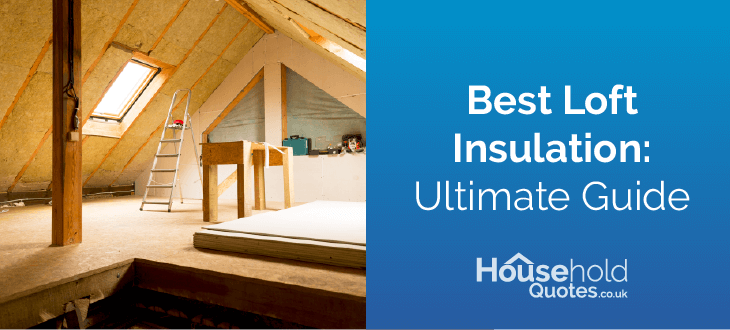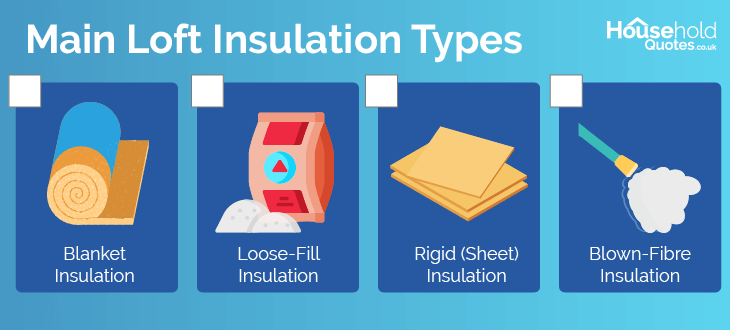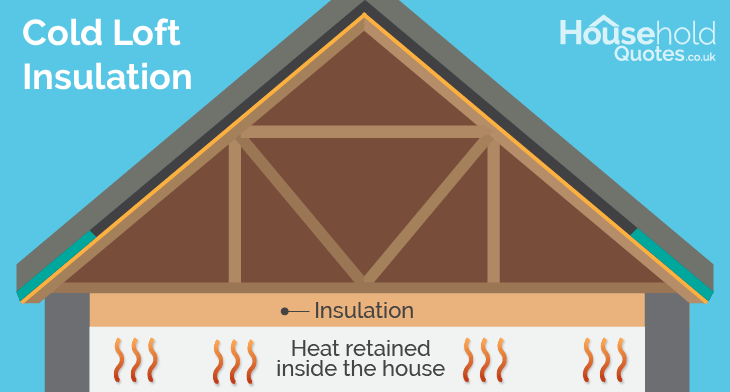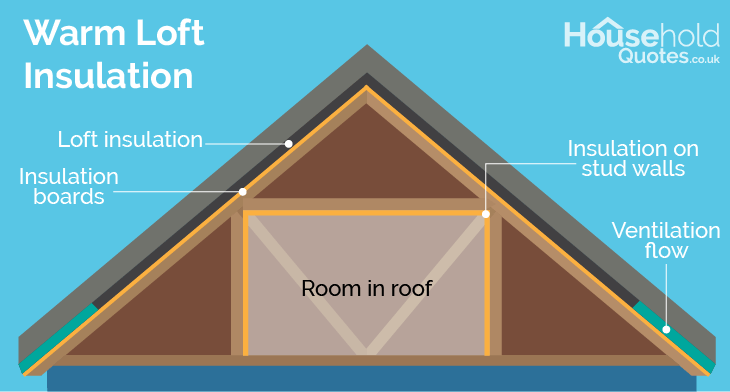
Tell us what you need to find a matching loft conversion specialist

Get free quotes from professionals near you

Compare offers and choose the one that best matches your need
- Householdquotes.co.uk
- Home Insulation
- Loft Insulation
- Best Loft Insulation
Best Loft Insulation: Guide, Types and Tips


- Homes risk losing up to 25% of their heat through uninsulated lofts.
- A standard semi-detached 3-bed home in the UK can save up to £270 on annual energy bills with proper loft insulation.
- The loft insulation types on the market are standard blanket, loose-fill, rigid board, and blown-fibre insulation.
Loft insulation is a domestic efficiency upgrade that every household can benefit from. Alongside slashing your home's heat loss by up to a quarter, it is one of the more affordable insulation projects to take up with a lifespan of over 40 years. Better yet, loft insulation has one of the shortest payback periods on your initial investment of just 3 years.
With all the options on the market, it can be a daunting task to decide which insulation is best suited for you. The good news is that this means there's an option suited for all budgets, loft types, and personal preferences.
In this ultimate guide, we will break down how to insulate a loft, the various loft insulation types, materials and tips to make sure you can find the best loft insulation material for your home.
Ready for sky-high savings with loft insulation? Look no further than Household Quotes UK to land the best bargain. Instead of spending countless hours surfing the web and setting up phone calls with installers, simply fill out our 30-second form and receive up to 3 free home-tailored quotes delivered right to you from our network of trusted installers. Click below to begin!
- Describe your needs
- Get free quotes
- Choose the best offer
It only takes 30 seconds



What is the best loft insulation?
There is no ‘single’ best loft insulation, and the right choice will depend on your budget, as well as the type of loft you have and want. The best insulation can also differ based on what you are comparing for, such as costs, heat retaining ability, or whether it can be installed DIY. Luckily, we will discuss everything you need to know in this article.
For starters, identifying the type of loft you want to have can help narrow down your options. For example, lofts that are intended for storage purposes need cold loft insulation, whereas lofts intended for living spaces require warm loft insulation, which is a more complex job. Both are discussed extensively later in the article.
When considering the best budget-friendly insulation, homes with previously installed insulation are in the best spot. If your loft already has some insulation in place that is dry and healthy, topping up to the recommended 270mm thickness is the most cost-effective way to upgrade your loft insulation.
Before deciding on the best insulation choice for your loft, let's start by checking out the key insulation types there are on the market.
Main types of insulation

If you’re wondering what is the best loft insulation to use, we can start by looking at the four main options that are normally seen in lofts. These are standard blanket, loose-fill, rigid sheet, and blown-fibre insulation. Each has its pros and cons, and the choice best suited for your loft will depend on your loft type, budget, and personal preferences.
- Blanket insulation: This insulation approach is the most popular choice amongst homeowners due to its affordability and ease of installation, even DIY. Normally made from fibreglass, mineral wool, or sheep's wool, they come in blankets, or rolls/batts, and are installed by being laid in between and over your floor joists and roof rafters.
- Budget-friendly
- DIY-friendly
- Eco-friendly options available, such as mineral wool or sheep’s wool.
- Can irritate skin and eyes during installation.
- Not ideal for awkward spaces.
- Requires a significant thickness (270mm) for proper insulation.
- Loose-fill insulation: Made from loose fibres that are spread in between the attic floor joists, this insulator is budget-friendly and easy to use. Normally made from fibrous mineral (rock) wool, fibreglass, or sustainable cellulose, it's a great option for homes with loft insulation in place that just need a top-up.
- Excellent for hard-to-reach areas and topping up existing insulation.
- Eco-friendly options are available (cellulose, cork, wood).
- Fast installation.
- Prone to settling and compression, potentially losing effectiveness.
- Requires professional installation.
- More expensive than blanket insulation.
- Rigid (sheet) insulation: These insulation materials are renowned for being one of the most effective for home insulation, but also one of the most costly. It is made from dense sheets of certain polymers and foams (e.g. polyurethane or polystyrene) and boasts qualities like fire resistance, high heat retention, and robustness against dampness.
- High-grade thermal performance.
- DIY-friendly for cutting and installation.
- Doesn’t compress or settle, making it a reliable long-term solution.
- Some of the most expensive insulation on the market.
- Synthetic options (PIR, EPS, XEPS) are energy-intensive to produce.
- Blown-fibre insulation: This insulation technique is when small bits of insulating material - such as wood, cork, or cellulose - are quite literally ‘blown in’ to your loft area through the use of professional equipment, instead of being installed as sheets or batts. It’s most useful for lofts that are unsafe or inaccessible, but are also great at insulating odd shapes, crevices and hard-to-reach loft areas.
- Eco-friendly options available (cellulose, mineral wool).
- Affordable (cellulose £10-£12/m²).
- Great for hard-to-reach areas and odd shapes.
- Requires professional installation and equipment.
- Unsuitable for damp lofts due to moisture absorption.
- Can settle or dislodge if poorly installed or in drafty lofts.
Now that we’ve had a run through the main approaches to loft insulation, we can explore what type of insulation is best suited for each loft type.
Best cold loft insulation

Cold loft insulation is a more affordable and practical method for houses that don’t intend to convert their loft into a habitable space. By insulating the floor of your loft, the living areas beneath remain warm, while the loft space itself is left uninsulated. Nevertheless, it can still serve as a storage area provided it's safe and accessible.
There are various methods of cold loft insulation, each tailored to fit different budgets and requirements:
- Best price insulation
Standard blanket insulation is amongst the most popular and budget-friendly options on the market, with the best loft insulation roll per cost being mineral wool at around £10 per m2. Compressed batts, an alternative to loose blankets, are just as convenient to install, water-resistant, and allow breathability, which helps prevent mould and rot down the line.
These are installed by lifting the floorboards to install 270mm of insulation between and over the joists, leaving a 50mm gap for ventilation before repositioning the floorboards on top. Most lofts may lack this depth, so loft legs or joist extenders can be purchased from a local hardware store to raise the floorboard height.
- Best heat-retaining insulation
Rigid (sheet) insulation - despite higher costs - boasts some of the most superior heat retention capabilities at less than half the thickness needed for blanket insulation. Polystyrene (EPS) or PIR boards are among the most cost-efficient, while the best loft insulation boards in terms of effectiveness tend to be Polyurethane.
Rigid boards can simply be installed by being cut into the desired length and fitted in between the floor joists and roof rafter. This often doesn't even require raising the floorboard height with loft legs given the high r-value of rigid insulation boards.
- Easiest to install insulation
Loose-fill insulation is ideal for lofts with existing insulation in place but is undoubtedly the simplest to install. For lofts that are already insulated but fall below the government-recommended 270mm thickness, loose-fill insulation is a cost-effective and easy way to top up existing insulation.
Available in bags in most hardware stores or online, it can be easily spread over and into gaps in the current insulation, a straightforward process that often doesn't require a professional installer for application.
Best warm loft insulation

Warm loft insulation is ideal when you are aiming to transform your loft into a habitable area. While this form of insulation is more intricate and expensive compared to cold loft insulation, it guarantees that your loft remains warm and consistent with the temperature of your home.
The process requires lining the inside of your roof rafters and the stud walls of the living area with insulation material to prevent heat loss to the uninsulated sections of your loft. Any windows or skylights will also need high-quality glazing and sealing to keep the draft at bay.
There are various methods for warm loft insulation, each offering its benefits. Here are some of the top choices:
- Best price insulation
Once again making an appearance, standard blanket insulation is often highlighted as being the best price loft insulation, as well as being widely available and easy to install. Available in rolls or slabs made from materials like mineral wool, fibreglass, or sheep wool, it can be easily placed between the roof rafters and on wall studs. It's typically held in place with netting before the plasterboard is applied.
- Best heat-retaining insulation
Spray foam insulation is recognised for its superior heat retention capabilities. It’s a synthetic, polyurethane-based expanding foam that delivers excellent performance. It’s usually sprayed into the spaces between rafters from the loft's inner roof during warm loft insulation. However, it comes with a high cost and needs professional installation. This cannot be done DIY.
- Easiest to install insulation
Rigid (sheet) insulation is a very high-performing insulator that is also easy and hassle-free to install. These boards, which can be cut and shaped as desired, can simply be fitted in between roof rafters and floor joists before being covered with plasterboard. Although more expensive, rigid boards are very effective in insulation, flame resistant, and very durable, making them worth the cost.
Best loft insulation material for rafters vs joists

Choosing the best loft insulation between rafters or joists hinges on several factors, including your budget, personal tastes, and the intended use of the loft.
Rafters are the structural supports for a roof deck, usually positioned vertically and found in sloped roof designs. On the other hand, Joists are the structural supports for floors and ceilings and typically lie horizontally.
The best loft insulation between joists is often with standard (blanket) insulation. This is a great cost-effective strategy but leaves the loft space itself uninsulated. It involves laying insulation material - typically blanket insulation - within the joists and then covering it with floorboards.
If you’re considering converting your loft into a living space, insulating between the rafters is a smarter move. It’s often recommended to insulate both joists and rafters if the loft will be used beyond storage.
- Foil insulation
Foil insulation is an aluminium-based, budget-friendly, and easy-to-install insulation option made of multiple layers of aluminium intertwined with foam insulation. Foil insulation is capable of reflecting up to 97% of radiant heat, offering effective loft insulation between rafters and joists. It is also safe to handle and can even be installed by yourself.
- Batt or slab insulation
These are composed of the same materials that make up standard blanket insulation but are instead compressed into brick-like slabs or batts, which often make installation easier. These can be cut into the intended shapes and slotted into the gaps between floor joists and roof rafters before being secured in place and covered with floorboard or plasterwork.
Tips for choosing the best loft insulation material
Choosing the best loft insulation material takes into account many things, most importantly the need to understand your loft and what you want to do with it. It will also help determine your overall loft insulation cost. Here are some starter tips that anyone considering loft insulation should look into:
- Storage or living space?: Lofts used solely for storage can get away with cold loft insulation, which is the insulation of floor joists. However, if you envision a home office, playroom or extra bedroom in the loft, you'll need warm loft insulation. This is a more thorough insulation approach that takes into account the entire loft space.
- Existing Issues?: Address problems like drafts, dampness, or mould before insulating your loft. Ignoring these issues can damage your insulation and compromise your home's structural integrity, leading to hefty repair bills down the line.
- Insulation check-up: Already have some insulation in place? A professional assessment can determine its effectiveness and whether it needs to be removed or not. If it's in good condition, topping it up to the recommended thickness might be the most cost-effective solution.
Once you’ve handled these matters, the next step is deciding on the type of installation you’d like to go ahead with. This will help narrow down the type of insulation material you can work with, as some require professional expertise, while others are more suitable for DIY projects:
- DIY: Offers cost savings two to three times less than a professional, but requires research and proper installation techniques. DIY is also more prone to faulty installations and heavy repair bills down the road.
- Professional: Ensures a proper installation for decades to come, optimal insulation performance, peace of mind, and adherence to government regulations.
Alongside these essential steps in getting your loft insulated, there is no better tip than proper research! Here’s an action plan of how you could do just that:
- Review materials: Make sure to read through this article to get a thorough understanding of different insulation materials, their pros and cons, and their suitability for your needs.
- Vet potential installers: Look for reputable professionals in your area. Check reviews, contact references, and compare quotes from multiple installers to get the best picture of potential installation costs.
- Compare deals: Don't settle for the first offer! Get multiple quotes from material suppliers and installers to land the best value for your home.
With all said and done, vetting for the right professional installer is no easy task. You could find yourself spending hours on end surfing websites and scheduling phone calls in an attempt to land the right bargain. Here at Household Quotes UK, we can free you of this burden.
Simply fill out our 30-second online form and receive up to 3 free home-tailored quotes from our network of accredited professional installers in your area. No extra charges, and no obligations to follow through. Click below to begin!
- Describe your needs
- Get free quotes
- Choose the best offer
It only takes 30 seconds



FAQ
While spray foam insulation tends to be one of the most effective in successfully keeping heat inside your loft, it comes with susceptibility to dampness formation. Another highly effective alternative is rigid (sheet) insulation boards, with polyurethane boards boasting some of the highest heat retention capabilities.
Thicker loft insulation is better, but only if you have less than the government-recommended 270mm loft insulation thickness. This also depends on the type of insulation material you have, as this recommended thickness normally applies to standard (blanket) insulation.
You don’t necessarily need to remove old loft insulation before laying new. Some existing insulation may be dry and in good condition, only requiring a top-up to a thickness of 270mm. This is far more cost and time-effective than starting loft insulation from scratch.
In most cases, 400mm loft insulation is more than what is necessary to keep your loft adequately insulated. The best loft insulation thickness as per UK government recommendations is around 270mm to 300mm, normally referring to standard (blanket) insulation.
It may be worth having up to 300mm loft insulation in place, but for most lofts, increasing more than this amount may not be feasible due to a lack of space, and the need to accommodate enough ventilation.
The best thickness for loft insulation is around 270mm to 300mm, as per UK government recommendations. Some homes may have up to 100mm loft insulation in place, and can simply top up for a fraction of the cost of starting a new insulation project.
270mm to 300mm loft insulation is considered the ideal depth for optimal loft insulation, but insulating to a higher thickness will likely not make much of a difference.
When considering cost-effectiveness, insulating capacity, and ease of installation, standard (blanket) insulation is probably the best budget-friendly option. As the most popular form of loft insulation, it is even possible to install it DIY or with a professional.

Akif has a keen interest in green home improvement solutions and the role of digital media in identifying climate trends. He aims to provide a multidisciplinary approach to content rooted in credible research and accuracy.
